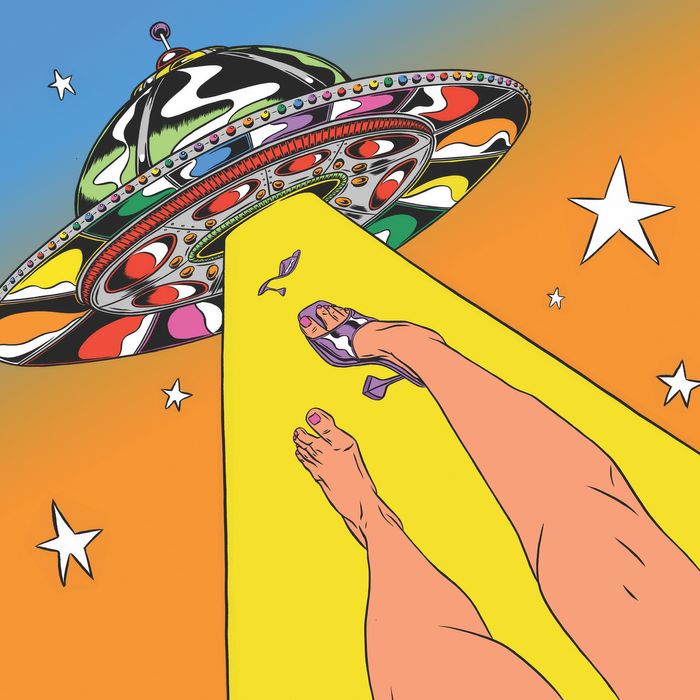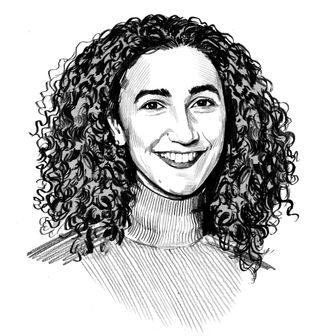
Taped to the side of Aya Kanai’s standing desk in her Brooklyn apartment is a list of acronyms. She received it last September after she had left her role as the editor-in-chief of Marie Claire to become the head of content and creator partnerships at Pinterest. The list, which came inside her onboarding packet, would help Kanai decipher the shorthand that comes up in meetings — abbreviations like CARE, which represents the categories of CPG (consumer packaged goods), auto, restaurants, and entertainment, and RAFT, which stands for retail, fintech, and telco (and further translates to retail, financial technology, and telecommunications).
Kanai, who had worked in fashion for over two decades, was fluent in a different insider language. She could probably tell you all about GOTs (going-out tops, not Game of Thrones) or why you should buy a PF21 MNZ LBD on TRR (a pre-fall 2021 Maryam Nassir Zadeh little black dress on the RealReal). This, in part, is why Pinterest poached her. The platform, at first popular among sorority girls and brides-to-be, was copying YouTube and Instagram and trying to strengthen its relationships with creators and influencers from the worlds of fashion and design. Kanai’s job was to translate between the two species: She would help the fashion people and other content creators understand how to use the platform, and she would help the designers and engineers better understand the desires of the influencers.
Kanai was, in some ways, following the latest trend among fashion editors. In January 2020, her predecessor at Marie Claire, Anne Fulenwider, took on an executive role at a health-tech start-up called Kairos. In February, Carolyn Kylstra, the editor-in-chief of Self, left for Google, and in April, Allure’s fashion director, Rajni Jacques, left for Snap Inc. After spending lockdown glued to TikTok, Vanessa Craft, the editor-in-chief of Elle Canada, decided to just go work for the platform in October. A month after that, Sally Singer, who had been at Vogue for 20 years, said au revoir to Anna Wintour’s inner circle and, after a hiatus, announced that she had joined Amazon as head of fashion direction. (Two other staffers followed shortly thereafter.) And this summer, Netflix poached two Condé Nast editors: Michelle Lee, the editor-in-chief of Allure, and Whembley Sewell, the editor-in-chief of Them, both of whom joined the publishing and editorial team.
“Once upon a time, editors-in-chief of glossy magazines would only vacate their posts if they were fired, died, or retired,” wrote Chantal Fernandez in The Business of Fashion in a piece about the magazine-to-tech “brain drain.” “But today, editors often see their spot at the top of the masthead as just another stepping stone.” What awaits them in the world of FAANG and IPOs isn’t just a fatter paycheck. (Guessing what exactly that salary might be is a masochistic game oftentimes played by media folk. My reporting suggests anywhere from $250,000 to $1 million with equity, though no one would confirm on the record.) For editors who have made their careers spotting the hottest new trend, tech also offers them the chance to feel like they have arrived at the beginning of something rather than a dead end (even if they are ten years late).
Generally speaking, it is not a new thing for media people to defect for a job in tech. But the Pied Piper for fashion editors specifically was Eva Chen. In 2014, one year after Chen was tasked with resuscitating Condé Nast’s shopping monthly, Lucky, the corporation announced that it was merging the magazine with the e-commerce platform BeachMint to create the Lucky Group — a last-ditch effort to save the title as print subscriptions plummeted. According to WWD, Chen’s new role was akin to “merchant-in-chief,” and she had to juggle several jobs that were below her pay grade, “including working as a merchandiser, writing copy, fulfillment.” In April 2015, Chen announced she was leaving Lucky, and in May, the magazine went quarterly — only to fold completely one month later, laying off swaths of staffers. Chen soon announced that she had joined Instagram as head of fashion partnerships. “The more I thought about it, I was like, I kind of have been doing this job already,” she told Fashionista. (Chen is on maternity leave and wasn’t available to be interviewed for this story.) “I would always email Charles [Porch, VP of global partnerships at Instagram] like, ‘You should really add this feature.’ ” She had also convinced big names like Karlie Kloss and Pat McGrath to join the platform before she was paid to do so.
At the time, Chen was an exception. Her editor-in-chief peers were, largely, still print veterans with golden-era salaries and were only just beginning to get hip to this whole digital thing. Over the next several years, many of them would be replaced in a less-than-gentle changing of the guard — Wintour, of course, being one of the few left standing. Meanwhile, their underlings — the digital editors, social-media managers, and audience developers who were young and good at being online — began to notice how much social-media metrics were dominating their jobs. Why sit in meetings all day discussing how to better serve the whims of Facebook when you could just go work for Facebook and make twice as much money? “I felt like half of the stories I was writing were just recaps of Instagram posts,” said Kristie Dash, Chen’s former assistant at Lucky, who joined Instagram in 2017. “I was like, Wow, so this is where we’re getting our story ideas and where culture is happening.”
In 2018, Derek Blasberg, a former editor at Harper’s Bazaar and Vanity Fair’s “Our Man on the Street” who was once described by this magazine as the “Truman Capote of Instagram,” was hired by YouTube to bring his pals like Naomi Campbell to the platform. Clearly, Chen’s industry connections had proved useful at Instagram, and its competitors were looking for hires with similarly stacked Rolodexes. After Blasberg got the job, he said, Chen emailed him and they went out for lunch. A few months later, Selby Drummond, who traveled in the same circles as Blasberg, left her life as a Vogue golden girl to become the head of fashion and beauty at Snap Inc., which she later left for Bumble. “When Selby took the Snapchat job, we looped her into our email chain, and we’d ask to sit next to each other at fashion shows,” Blasberg said.
By 2019, digitally savvy editors, like Kanai and Craft, occupied top positions at fashion magazines. But the industry had entered a period of austerity, and the life of an editor-in-chief was no longer flush with leisurely power lunches and bloated photo-shoot budgets the way it once was. Instead, those in senior roles were tasked with bailing out the ship while steering it. As the fashion director at Allure, Jacques found herself not only overseeing print, digital, and video fashion stories but producing branded content: “Budgets were getting cut, and it was like, ‘Hey, can you do this job, too?’ ” In April, Jacques took a job at Snap Inc.
When I ask former fashion editors about their new tech jobs, all of them cheerfully describe how well their previous roles prepared them for their current ones. “As an editor, we tell stories for people,” Dash says. “And now we’re helping people tell their stories in the best possible way on Instagram.” (During these calls, I should note, there was often a publicist listening in.) Instead of controlling what content gets made — in, say, the form of a fashion spread — they now help others create that content themselves. They will meet with everyone from Donatella Versace to employees at Goop to teach them how to best use the app’s tools and filters. They use the word empower a lot. Instead of anointing the Next Big Thing by putting them on a magazine cover, they now help identify who and what is trending by promoting their accounts or partnering with them.
Other former fashion people, like Kanai, work closely with product managers, coordinating with engineers and programmers to figure out how to design the features that influencers and creators want. (Hence the cheat sheet.) At Pinterest, she has worked on tools that allow users to narrow their search by skin tone and hair texture.
By this point, these platforms are less interested in convincing more people to use them than in getting the people who already do to linger and buy something. Just a few weeks ago, my LIKE button on Instagram curiously switched to a shopping-bag icon, and it’s not a coincidence that more fashion editors are being hired by tech platforms at the same time they are competing to expand their e-commerce capabilities. This summer, Pinterest rolled out a feature that allows creators to tag products and earn commissions through affiliate links — a function that already existed on TikTok and Instagram.
For some former editors, the new abundance of money and resources means less cynicism, less scarcity, and more freedom. “There was no ‘ceiling’ when it came to being creative,” said Jacques. “I’m more bright-eyed about things now, instead of being jaded.”
But, I wondered, did they miss the life of fashion magazines, even a little bit? The late nights spent toiling over whether someone should be smiling or pouting on a cover? Walking into an office and having their co-workers go, “Oh my God, is that Dries?”
“I think the two things that these people coming from media underestimate is that a lot of the job is very boring and that you are making significantly smaller decisions than you were making before,” said an editor who has worked in both tech and media and asked to remain anonymous because of their NDAs. “Your decisions are going to affect way more people because of the scale of the tech company. But what you have creative jurisdiction over is vanishingly small compared to what you were able to make decisions about in media because there are so many more people who approve everything. Editors-in-chief generally have the last word, and they do not at a tech company.” A few fashion editors, like Simone Oliver, have come back. In 2017, she joined the magazine-and-lifestyle-partnerships team at Facebook but left when she landed the role as editor-in-chief of Refinery29 last fall. In tech, she said, “you might be helping, advising, guiding” content, but you’re not creating it. She wanted back in the trenches.
It’s possible, of course, that these former fashion editors crave the clout they once had at the top of mastheads. But you can’t buy a house with cultural capital alone, and the equity accrual these tech companies offer makes it hard to leave. And most still plan to attend Fashion Week. For those who have long careers ahead of them, tech also offers just that: a certain future with a lot more options. Many people, Dash said, have since asked for her advice on how to make the shift. “Honestly, when I started working here four years ago, so many of my peers in their 20s were already becoming directors or even editors-in-chief at magazines,” she said. “I’m like, Okay, that’s amazing and inspiring. But then what?”
More From Fall Fashion 2021
- The People Who Make Those $10,000 Couture Gowns
- Am I Ready to Become a Hat Girl?
- The Global Pursuit of a Bigger Butt






